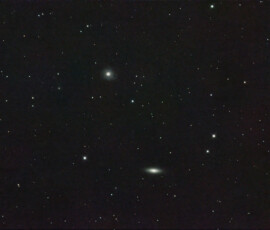NGC 4041 is a spiral galaxy in the constellation Ursa Major. It is located an estimated 74 million light years from the Sun. The morphological classification of SA(rs)bc indicates that this is a spiral galaxy that lacks a bar; the ‘rs’ means it has a weakly-formed ring structure, and the ‘bc’ indicates the spiral arms are moderately to loosely wound.
The galaxy is inclined by around 20° to the line of sight from the Earth. It is forming new stars at the estimated rate of 4.10 M☉ yr−1, which is fairly typical for a galaxy of this morphology. This galaxy has no detected activity in the nuclear region. There is a rotating nuclear disk of high brightness at the core that is consistent with the presence of a supermassive black hole (SMBH).
NGC 4041 is a member of the LGG 266 galaxy group, along with NGC 4036, IC 758, UGC 7009, and UGC 7019. It is located just 17 arc minutes from NGC 4036, and the two form a pair with a projected separation of around 470 kly.
NGC 4036 is a lenticular galaxy in the constellation Ursa Major. In the Carnegie Atlas of Galaxies, it is described as being “characterized by an irregular pattern of dust lanes threaded through the disc in an ’embryonic’ spiral pattern indicating a mixed S0/Sa form.”
The galaxy is being viewed nearly edge-on, with an inclination of 18° to the line of sight from the Earth. This is a type of active galaxy known as a LINER, which means that it shows emission lines of ionized gas in the region of its nucleus. Chemically, the stars at the center of the nucleus have a higher metallicity than in the neighboring regions. It appears that there is a tilted disk of stars orbiting the nucleus within a radius of 820 ly (250 pc). The galactic bulge itself appears triaxial with the ionized gas concentrated near the center of this bulge region. Such features are common in Seyfert galaxies.

